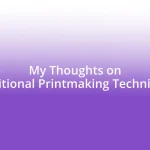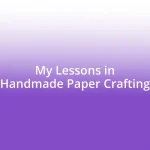Key takeaways:
- Emphasizes the journey and personal growth in leathercrafting rather than just the finished product.
- Identifies essential tools for leathercrafting, including a rotary cutter and the importance of using quality stitching materials.
- Highlights the significance of choosing the right leather type and understanding its properties for project success.
- Stresses the value of preparation and using the correct techniques to improve outcomes, avoiding common mistakes like rushing or using inappropriate tools.
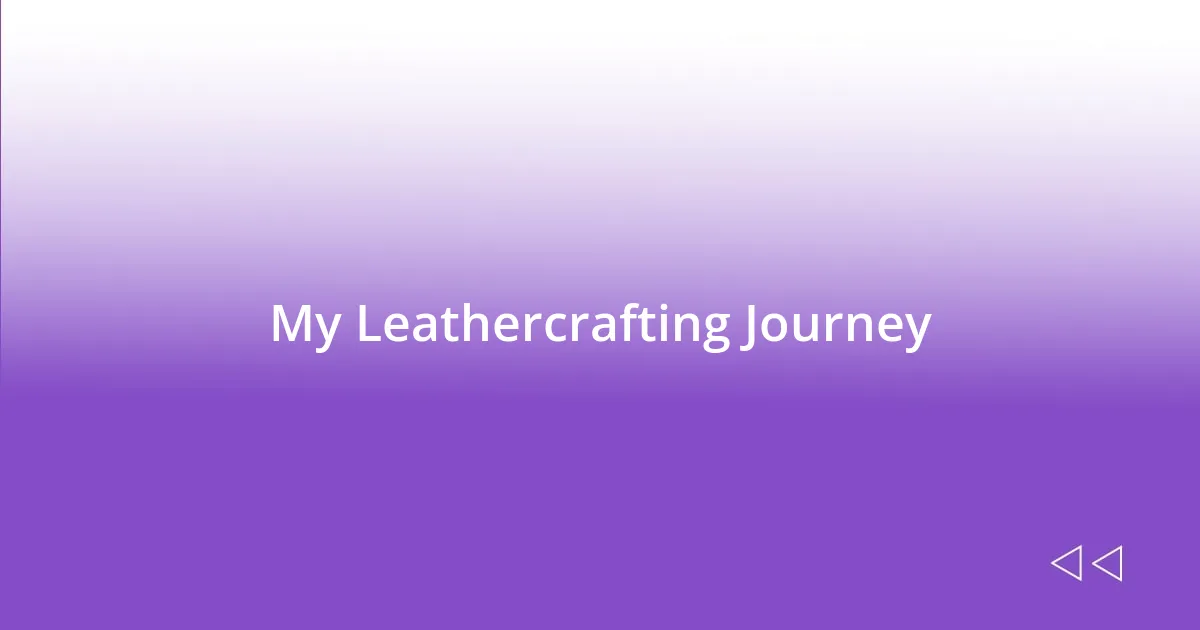
My Leathercrafting Journey
I remember the first time I held a piece of leather in my hands, feeling its unique texture and warmth. As I ran my fingers over its surface, I couldn’t help but wonder what stories it could tell. Each time I cut or stitched, it felt like I was uncovering those hidden tales, transforming raw material into something personal and beautiful.
There was a moment when I was struggling with a particularly challenging project—a wallet that seemed to resist my every attempt. Frustration was building, but as I stepped away to gather my thoughts, I realized that these roadblocks are part of the learning process. Have you ever felt that rush of satisfaction when figuring out a tricky section of your craft? It’s like discovering a piece of yourself you didn’t know was there.
Fast forward to today, and I often reflect on how far I’ve come. Each creation is a labor of love, a blend of skill and emotion. Remember that joy you feel when you complete a project? It’s not just about the finished product; it’s about the journey that brings you there, each stitch echoing the lessons learned along the way.
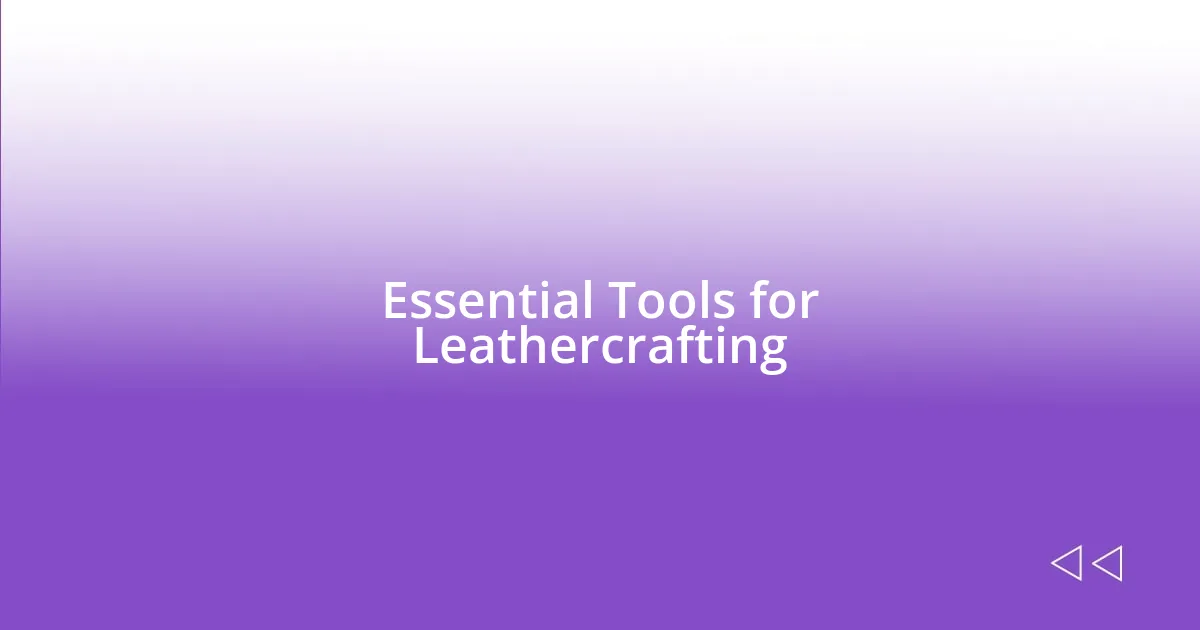
Essential Tools for Leathercrafting
When it comes to leathercrafting, having the right tools is crucial for success. My most indispensable tools include a good-quality rotary cutter and cutting mat. I still remember the first time I tried to cut leather without one; the results were jagged and frustrating. Investing in these tools transformed my work. It was like switching from a dull knife to a sharp one—it made all the difference!
Another must-have in my toolkit is a quality set of stitching tools, including needles, thread, and a pricking awl. Initially, I underestimated the importance of using the right thread. I tried to cut corners with regular thread, only to have my stitches unravel after a few weeks. Once I used specialized, waxed thread for leather, my projects not only looked better, but they also stood the test of time—truly a game-changer!
Lastly, don’t overlook the power of edge tools and finishes. After struggling with rough edges, I invested in an edge tool and learned to burnish properly. The moment I saw the difference it made to my finished projects, I felt like a professional. Do you remember the first time you saw your work elevate with the right tools? It’s a feeling that stays with you, pushing you to tackle even bigger challenges.
| Tool | Purpose |
|---|---|
| Rotary Cutter | For precise cutting of leather |
| Cutting Mat | Protects surfaces while cutting |
| Stitching Needles | Used for hand-stitched seams |
| Waxed Thread | Provides strength and durability |
| Edge Tools | Used to smooth and finish edges |

Choosing the Right Leather
Choosing the right leather is fundamental to your crafting success. I vividly recall my first decision to use vegetable-tanned leather. The smell of it was intoxicating, and its ability to age beautifully over time captivated me. However, not all leathers are created equal. Researching and understanding the different types of leather can drastically influence your project’s final outcome.
Here are key considerations when choosing leather:
-
Type of Leather: Different types, such as full-grain, top-grain, and suede, each offer unique qualities. Full-grain leather is durable and develops a rich patina, while suede has a soft texture ideal for certain projects.
-
Thickness: Thicker leather is better for bags and belts, while thinner leather works well for wallets or apparel. Picking the correct thickness saves hours of heartache later.
-
Finish and Treatment: Understanding whether your leather has been dyed, waxed, or treated can help you decide how it will look and age. For example, untreated leather absorbs colors and oils beautifully but requires more care.
-
Source: Always consider where the leather is coming from. Sustainable sources can enhance your experience and connect your crafts to the stories of their origins.
Every piece of leather I choose now feels like a purposeful decision—a step toward creating something meaningful. That connection is what truly enhances the crafting experience.
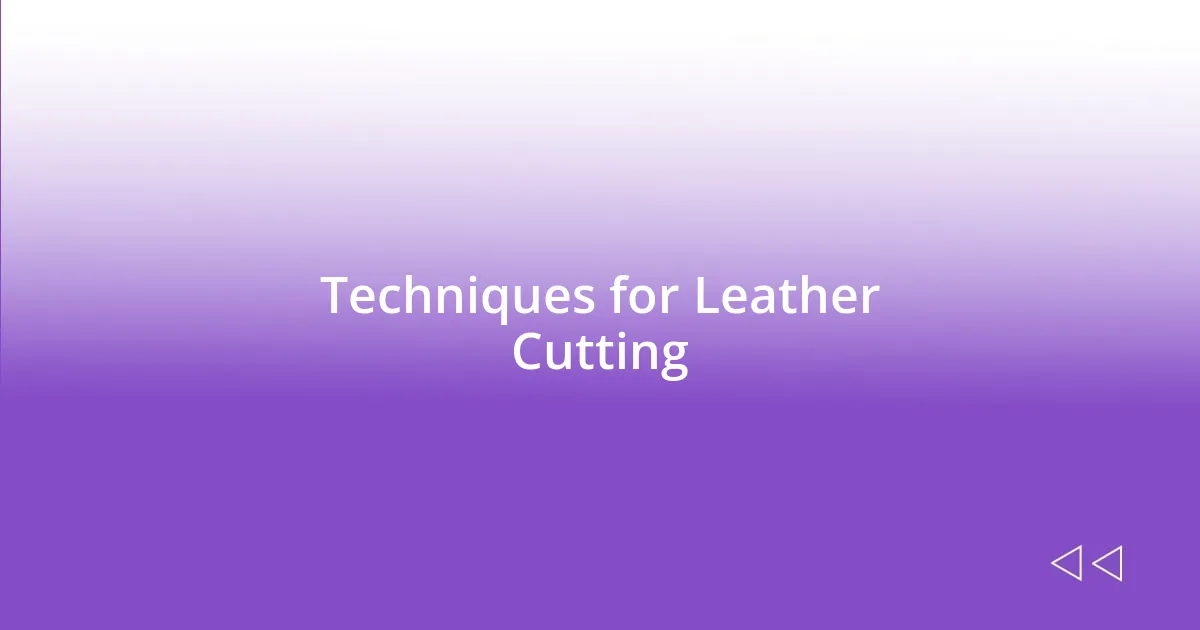
Techniques for Leather Cutting
When it comes to cutting leather, precision is key. I fondly remember my early days in leathercraft when I often ended up with uneven edges. It wasn’t until I learned the technique of using a straightedge or ruler that everything changed. I realized that taking the time to measure and securely anchor my tools made my cuts cleaner and more professional-looking.
One technique that I’ve found invaluable is the “score and snap” method. For thinner leathers, I would lightly score along the cutting line with a sharp utility knife, then firmly snap the leather along the score. It feels almost like magic when the cut goes perfectly straight! Have you ever experienced that satisfying sound of a clean break? It’s a small but rewarding moment that adds to the joy of crafting.
Lastly, using a cutting mat with grid lines has transformed how I approach leather cutting. I can align my leather to the grid, which helps ensure that each section is cut to the desired size. This wasn’t something I thought much about initially, but I quickly learned to appreciate its importance. It’s these little techniques and adjustments that have truly helped me elevate my leatherworking projects. How have you set yourself up for success in your crafting journey?
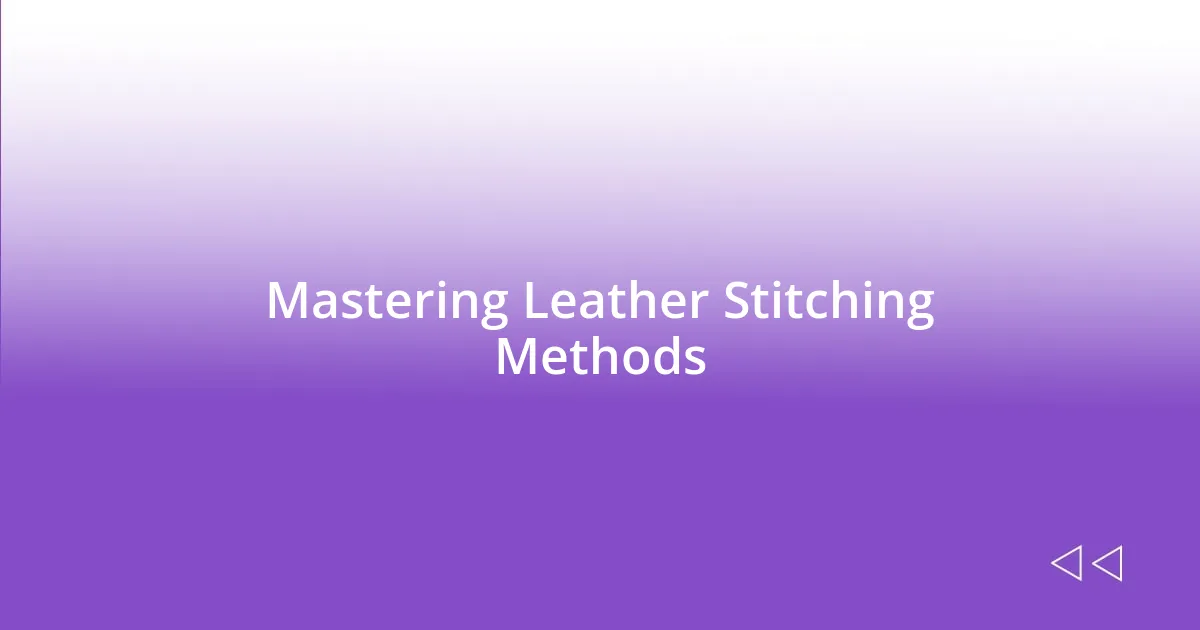
Mastering Leather Stitching Methods
Mastering Leather Stitching Methods
Stitching is where the magic of leathercraft truly shines for me. I remember my first attempt at saddle stitching; it felt like threading a needle with my own dreams! Mastering this technique not only strengthened my pieces but also gave them a handcrafted charm that a machine simply can’t replicate. Have you ever felt that sense of accomplishment when your stitches line up perfectly, creating a beautifully finished edge? It’s exhilarating!
One practical tip I’ve picked up along the way is using a stitching pony. This tool holds your leather securely, allowing both hands to focus on the stitches. It’s made me realize how crucial it is to create a steady environment while working. When I first tried stitching without one, my results were shaky, and frustration crept in. Now, I treat my stitching pony like an old friend—it’s indispensable for maintaining focus and ensuring precision.
Lastly, I can’t emphasize enough the importance of choosing the right thread. I once struggled with a synthetic thread that kept breaking, turning what should have been a joyful process into a test of patience. Switching to waxed linen thread not only solved that problem but also added a delightful texture to my projects. Have you ever experimented with different materials? There’s a world of difference waiting to be discovered, and it’s those discoveries that breathe life into our leathercrafting journey.

Finishing Touches for Leather Projects
Finishing touches can truly elevate a leather project from ordinary to extraordinary. I still remember the first time I applied edge finishing to a wallet I made; the difference was astounding. I used an edge beveler to round off those sharp edges—just seeing the transformation filled me with pride. Coupled with a bit of edge burnishing, that wallet went from looking handmade to looking like a piece of art. Have you ever taken a moment to appreciate the subtlety of smooth edges?
Another important aspect is the leather conditioner. After spending hours crafting your piece, don’t forget to treat it with love! When I first completed a bag and skipped this step, I quickly noticed it losing its luster. A good conditioner not only nourishes the leather but also enhances its natural beauty, bringing out those rich tones that can make your project shine. It’s fascinating to see how a simple product can make such a profound impact, right?
Lastly, I’ll never forget my first experience with applying a finish. I was anxious as I brushed on the acrylic finish, fearing I’d ruin all my hard work. But once it dried, the project glimmered beautifully, and I felt an overwhelming sense of satisfaction. It taught me that sometimes, it’s the last step that gives your creation its life and character. Have you experienced that breath of fresh air when the final touch makes everything come together?

Common Mistakes to Avoid
When diving into leathercrafting, one common mistake I’ve encountered is underestimating the importance of preparation. I remember my first project—a simple leather pouch. I was so eager to cut and stitch that I neglected to properly transfer my pattern onto the leather. The result? A beautiful idea that ended up being lopsided and mismatched. Have you ever rushed into a project only to realize later that a little planning could have made all the difference?
Another error I’ve made is using the wrong tools for the job. Early on, I attempted to cut leather with a standard pair of scissors, thinking it would work just fine. The struggle was real! The edges were jagged, and I learned quickly that a dedicated rotary cutter is a game-changer. It’s essential to invest in the right tools; they can turn a frustrating task into a smooth process. Do you have a go-to tool that makes your crafting experience more enjoyable?
Lastly, don’t overlook the drying times of adhesives and finishes. There were times when I was too impatient to wait for my glue to set before moving on, resulting in messy joints that simply wouldn’t hold. I learned that taking the time to let things dry completely is not just a suggestion; it’s crucial for the integrity of your piece. Have you found it challenging to practice patience while crafting? Trust me, those extra moments of waiting are often what lead to craftsmanship you can be truly proud of.




